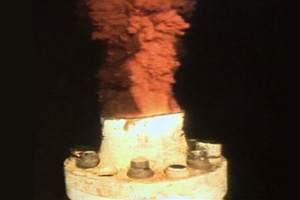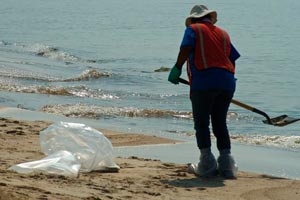BP and federal spill responders announced last night that the first relief well has successfully intercepted the leaking well that gushed from the bottom of the Gulf for nearly three months. BP’s main well has been contained with a cap since July, but the relief well was billed as the only way to finally and completely close the well and bring an end to a disaster that released 4.1 million barrels of oil into the Gulf of Mexico.
National Incident Commander Admiral Thad Allen announced late Thursday night that the relief well had tapped into the leaking well, which will now allow drillers to cement the well and complete the so-called bottom-kill operation. That operation is expected to be completed on Saturday, BP said. The first well was expected to be completed in mid-July, but between weather delays and other setbacks, it took much longer.
But as the nightmare well meets its end, new research is indicating that much of the oil is remains in the Gulf. Research published this week in Science indicates that there may be four separate plumes of hydrocarbons under the water. David Valentine, a professor of microbial geochemistry in the Department of Earth Science at the University of California, Santa Barbara estimated that there’s “about a million barrels of oil” contained in these plumes (approximately a quarter of the total amount of oil spilled in the Gulf). And there’s about two times as much gas in the plumes, said the researchers. (I reported more on the additional problems that all that gas creates in the Gulf in this July piece. Valentin also makes an appearance in Julia Whitty’s cover story this month on the BP spill.)
The research also suggests that bacteria in the Gulf are consuming the propane and ethane released from the well faster than they’re consuming more complex hydrocarbons like methane and oil. Propane and ethane were the “primary drivers of microbial respiration,” the research team found, accounting for up to 70 percent of the oxygen depletion in the undersea plumes. (As the microbes feast on the hydrocarbons, they must use oxygen in the water, which is why the oxygen depletion levels are used to gauge their activity.) This puts a bit of a damper on reports released a few weeks ago claiming that Gulf microbes were eating oil at record rates.
This also comes after reports earlier this week that scientists have found oil accumulating on the Gulf floor and that new waves of oil have washed ashore in Louisiana—still more evidence that more of the oil is lurking below the surface than rosy reports last month had indicated.












